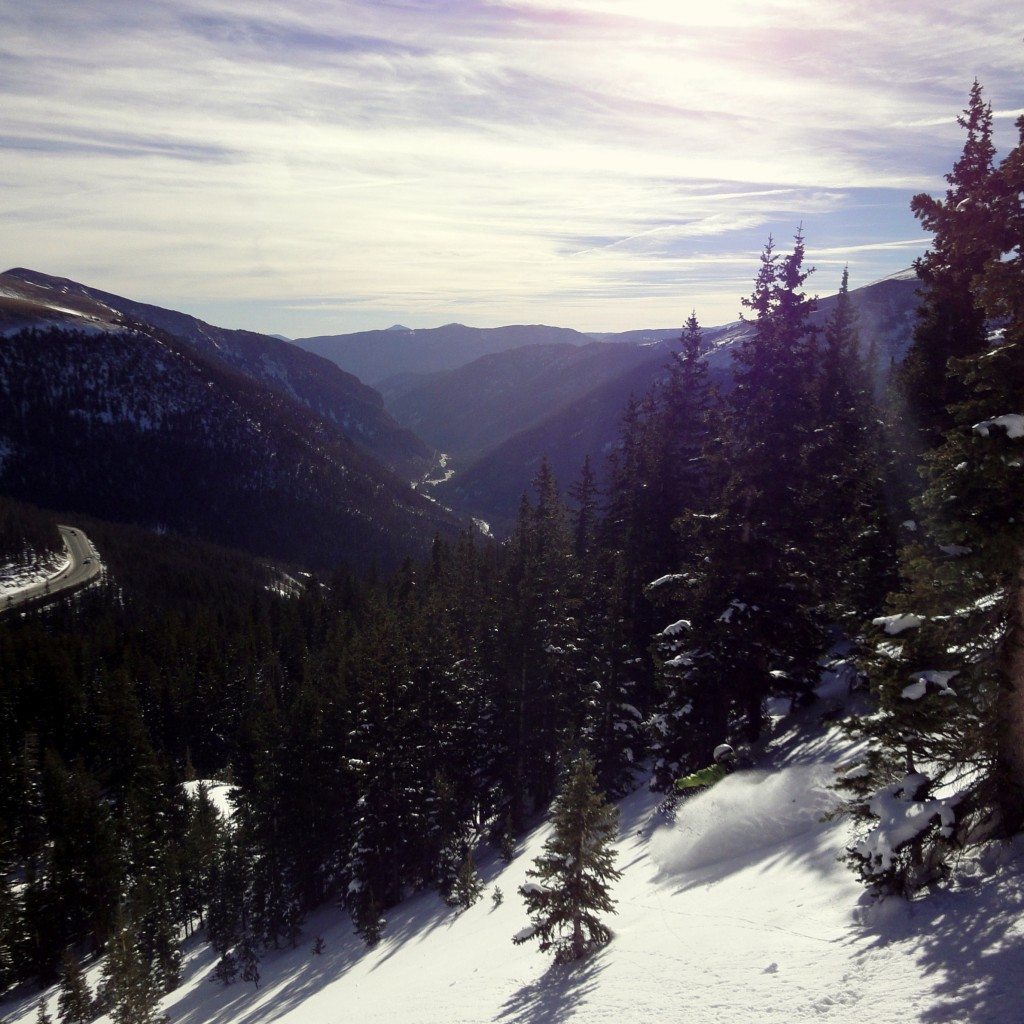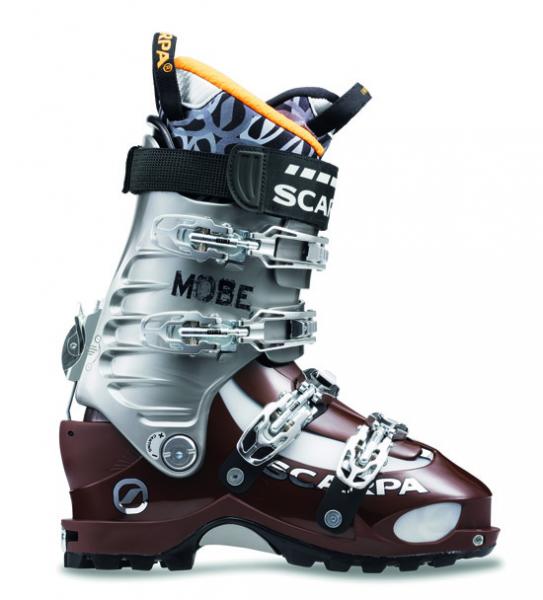Boots: Scarpa Mobe, size 27.5, 104mm last
Skier: 6’2”, 210lbs, athletic, technically proficient, fast and fluid skier.
Foot: size 10.5 / 11 street shoe, c+ width (105mm width, static/weighted), high instep, low volume ankle and lower calf.
My regular ski boots: Nordica Jah Love, 98mm last, 130 flex with no grinding or punches.
Conditions tested: Backcountry powder, sun effect, wind effect, inbounds soft, chalk, firm. Basically everything.
Duration of test: 30 days.
The Scarpa Mobe boot was lust-worthy when it arrived. It is quite well made, and a lot of attention has gone into designing a boot with a fair amount of lateral stiffness and a nice, progressive forward flex. It also felt light in my hand out of the box. I was excited to test this boot and I quickly developed high hopes for it – to the point that I was dreaming of getting rid of my alpine boots and just skiing the Mobe every day. For me, that is saying something, since I’ve never been impressed enough by any touring boot to consider skiing in one all the time.
Touring around my living room in the Mobe, the walk mode certainly seemed adequate. The boot has significantly more articulation than the Black Diamond Factor or the Salomon Quest, but it offers slightly less range of motion than the Dyanfit Titan. I found myself walking at only a slightly diminished stride in this boot compared to a true backcountry boot.
About halfway through my test period of the Mobe, I added the aftermarket “Touring Tongue,” which was a big upgrade. It helped to free up the stride, which was great, but more surprisingly, it also added to the downhill ski performance. The touring tongue should be regarded as a “must” upgrade.
The Scarpa Mobe is very easy and intuitive to adjust. The cant bolts are effective, work well, and do not slip. It is simple to adjust forward lean if you like, and all of the buckle and ladder hardware is easily moved around – no hardware is riveted on.
Unfortunately, my love affair with the Scarpa Mobe was somewhat short lived. Because it is such a nice boot for all of the reasons stated above, I fiddled with the shell a bunch. Ultimately, however, my problems with the Mobe center around a non-specific fit that I couldn’t alter enough to make the boot work for my foot. I have an extensive boot fitting background, and am well versed in the appropriate measures to remedy fit issues in a boot. I’ll detail here all of the experiments I tried.
I began skiing this boot “au naturale,” only adding my orthotic and baking the Intuition tongued Luxury liner. The fit felt nice right out of the oven, which made me nervous, as I expected the Intuition liner to settle into its final dense shape after 2-3 days of skiing. I skied the Mobe for two days in the backcountry (about 12,000 vertical feet total) without any further adjustments, and by the end I was having a bit of a hard time controlling the ski the way I am used to in a proper-fitting alpine boot. I hated to admit it, but the boot felt less precise and less responsive than my alpine boots, and I was experiencing significant heel lift when weighting the shovel of my skis.

I attempted to fix this by first adding one, then two layers of Bontex brand fiberglass boot board to raise my foot up in the shell. (Later, I tried adding a heel wedge.) That first layer of Bontex got the boot skiing a little bit better, so I tried adding a second layer. Due to my high instep, however, that additional layer put my foot into a position that caused significant pain and cramping along the top of the foot. So after a few days of skiing, I removed these various shim arrangements. I then ran into the same cramping issue when I inserted a heel wedge.
Okay, what next? I tried using a thicker and more dense foam liner, the Intuition Powerwrap Pro Plug. This liner is slightly stiffer, thicker, and more dense than the stock liner, and offered some improvement in performance. However, I was still not seeing the performance I felt was possible, so I continued to experiment. I added several “C” shaped and “L” shaped heel pads (seen 2/3rds of the way down the page HERE) in the attempt to better lock down my heel – “C” pads first and then “L” shaped pads right on top of them – to double the grip of the boot’s heel pocket.
The added pads helped to keep my heel down, but unfortunately not enough. Taking a closer look at the shape of the lower portion of the shell, I noticed a significant gap between the shell and the top of my foot at the fold of the ankle. My foot was almost an inch below the shell at this point, but fit well everywhere else.
It is incredibly important to get the fit correct in a ski boot at the fold of the ankle. It is critical to lock this part of the foot down because it holds the ankle down and back in the heel pocket and prevents the foot from slamming forward, resulting in black toe nails. In my opinion, the shell shape of the Mobe at this spot seems to be of a poor anatomical design.
I tried to solve this issue by adding a bunch of foam padding to this area of the tongue, hoping to gain a little pressure on the front fold of the ankle. I then switched to the touring tongue, which is thicker due to its pivoting arrangement here. I found that the touring tongue actually increases the boot’s progressive flex, and really upgrades both the skiing and walking performance. (If you get the Scarpa Mobe, get the touring tongue.) But while the touring tongue did help to reduce the excessive space in this area of the boot, I have found no way to overcome what I believe to be a critical design flaw in the shape of the lower shell.
Summary: If the Scarpa Mobe shell fits you correctly – or you are simply less picky about a highly anatomical shell fit – then this boot deserves a serious look. It skis great if you can get it to fit. And I strongly recommend the touring tongue. It definitely makes the boot ski better by slightly softening the initial flex and then smoothly ramping it up through the flex pattern. It also enables a longer stride for touring. If, however, you are after an anatomically accurate boot (and I’m not talking about a super aggressively fitted, alpine boot), then you probably ought to keep looking. Compared to my Nordica alpine boots, the Mobe fit like a bucket, no matter how many shims or adjustments or different liners I tried. And since I couldn’t get the fit I was looking for, I couldn’t get the performance I was looking for either. This is a shame, because everything else about the boot really works well together.


I can’t seem to find that sort of touring tongue anywhere online. Any ideas?
Any and all Scarpa dealers ought to stock them or have easy access to them.
They fit most Scarpa tongue boot designs.
I wanted to chime in because I like that your review admits your slant (i.e. that you don’t fit it), but also because I wouldn’t say Scarpa has built an a boot that is NOT anatomical. I say this because it fits me like a glove out of the box, except for some necessary punching at the sixth toe. I have very thick, muscular ankles and heels, though am not a clydesdale (5’10” 185 lbs). I know some people who have always had trouble with fitting the heel of Scarpas, and others, like me, who have felt that no other boots off-the-shelf do us any service like Scarpa does.
Just a guess, but perhaps you have more svelte ankles and heels? I add this only because I want the Mobe seen in a fair light for those who have to buy before they try.
adam, thanks for the comment.
i would just like to offer the counterpoint that while it is very easy to remove material and relieve pressure points in the heel-pocket, it is impossible to effectively add material to further lock-down the heel.
everyone has some degree of shelf off the backside of the calcaneus. my point on the Mobe heel pocket shape has much less shelf that some boots, and there for does not match the anatomy of a very large percentage of human beings, hence the “not anatomic”.
did not mean to say that it will not fit anyone at all, more the point was that if you do have a pronounced calcaneus, this boot will need significant padding (which i tried with little luck), or you should keep trying boots on.